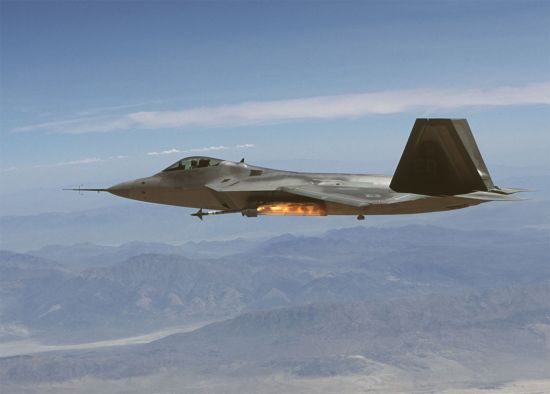|
||||||||||
|
|
||||||||||
|
||||||||||
|
|
||||||||||

The two center bays can each carry up to three AIM-120C AMRAAM radar-guided beyond-visual-range air-to-air-missiles. The AIM-120C variant uses shorter-span fins than earlier AMRAAM models and was built to better fit within internal bays like those of the F-22 and future stealthy aircraft. If necessary, the aircraft can also carry the AIM-120A, but only two of these larger missiles can be carried per bay. In the air-to-air combat mission, the F-22 can therefore carry a maximum of eight missiles and still retain its ideal stealth characteristics.
If stealth is not required, additional missiles can also be carried externally on underwing pylons. The F-22 can be equipped with four external pylons, two beneath each wing. These extra hardpoints are intended primarily for ferry missions, but each can be configured to carry two AIM-120 or AIM-9 missiles on a LAU-128/A launcher. This extra carriage capacity provides room for an additional eight air-to-air missiles, allowing a maximum of 16 between the internal and external loadouts.

Aside from an internal M61A2 Vulcan cannon, the only other weapon system carried by the F-22 as it enters service is the GBU-32 JDAM guided bomb. The GBU-32 is based on the 1,000-lb Mk 83 general purpose bomb but fitted with a tail kit that uses GPS-guidance to make precision strikes against ground targets. In air-to-ground attack mode, the F-22 can carry one GBU-32 plus a single AIM-120C in each of the main weapons bays. The maximum weapon loadout in a stealthy ground attack mission is two bombs plus four air-to-air missiles, including the side bays. The underwing pylons are also compatible with JDAM, but there are as yet no plans to carry bombs externally.
As mentioned earlier, the principal function of the underwing pylons is for long-range ferry missions where extra fuel is required. Each of the pylons can carry a 600-gal fuel tank or a fuel tank and two AIM-120 missiles. However, these missiles cannot be launched since the fins must be removed. A typical ferry mission would have the aircraft carry these extra missile bodies on the pylons with their fins stowed in the side bays. These missile components would be transported to a forward operating area for reassembly and use.

In a non-stealthy combat mission, it is likely that the aircraft would compromise between the maximum missile and
fuel loads. The inboard pylons would be occupied by two fuel tanks while four missiles would be located on the
two outer pylons, as illustrated above. This arrangement allows a maximum missile load of twelve: six AIM-120
internally, four AIM-120 externally, and two AIM-9 internally. It should also be noted that the F-22 will enter
service in late 2005 with the ability to launch missiles from the internal bays only. It is assumed that the
ability to launch weapons from the underwing pylons will be developed shortly thereafter.
- answer by Jeff Scott, 1 December 2002
Related Topics:
What type of airfoil is used on the F-22 Raptor? What is its name?
Read More Articles:


|
Aircraft | Design | Ask Us | Shop | Search |

|
|
| About Us | Contact Us | Copyright © 1997- | |||
|
|
|||